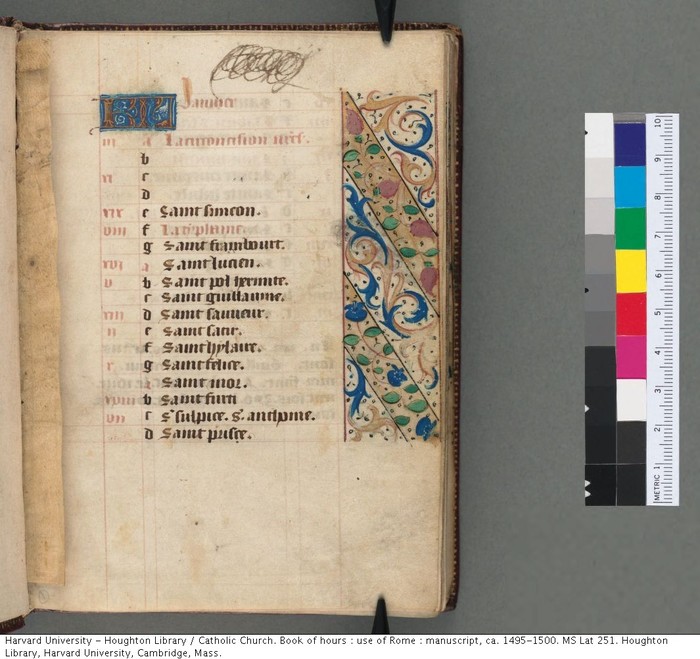A slew of Spanish Hours are coming in the near future, thanks to the detailed catalogue information in Josefina Planas’. Horae: el poder de la imagen : libros de hores en bibliotecas españolas. (Madrid: Orbis Mediaevalis, 2016). These are mostly not actually Spanish-made manuscripts, sadly, but a broad spectrum of French, Flemish, and Italian MS that are presently held in Spanish collections.
The first of these to be added is from the Biblioteca Nacional de Espagna, Vitr 23 10. This 13th C Parisian book is known as the Clinton Book of Hours, from the 15th C british owners. This manuscript starts with a long pictoral sequence, depicting two scenes of St. Edward the Confessor and then the life/death/resurrection of Jesus, leading to the calendar starting on f.29v.
The calendar itself is not graded, it uses gold and blue ink without obvious pattern. There is a tendency for lone important feasts to be gold, but when entries cluster they fall to simple alternation. Outside the main entries there are some of the Zodiac signs, 5 months, and many of the other informational notes (dates for easter and Rogation Keys). There are also several obituaries for members of the Clinton family in a later hand, in brown ink. The main entries are rather sparse, 142 dates populated, and most are the basic Parisian saints. With the exception of a row shift at the beginning of October(see f.37v below), the entries are accurate with only one incorrect entry elsewhere.
(DB Id: 279)
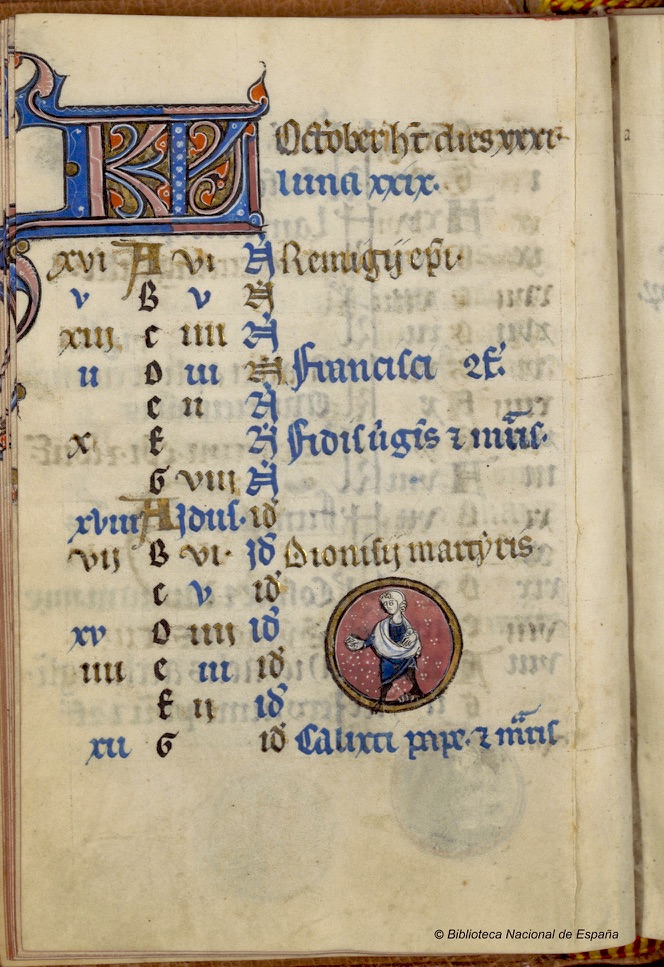
From the Bibliothèque nationale de France comes Latin 1173, the Hours of Charles d’Angoulême, made in France in the Late 15th C. Charles was the father of King François I(r. 1515-1547), and is identified by his arms on f.53r. The Hours are Use of Paris, but the calendar has not been localized.
Most of the literature on this MS is not focused on the text at all, but either the miniatures. Many of these are originals by Robinet Testard, but several are actually prints by Israel van Meckenem (signed IM), which have been colored and embellished by Testard. The calendar is populated with quite distinct illustrations. The labors of the month are unusual and 9 of the KL initials are formed by humans, often in brown/blue clothing, contorted and posing with strange beasts. May (f.3r below) is a representative example, with the woman seemingly unconcerned by the dragon attacking her to form the arms of the “K”. What seems to be the labor is, in fact, two “wild men” jousting
In the content of the calendar there are both some unusual saints listed as well as an interesting bit of scribal error. The calendar starts out mostly full, 27 in Jan, but immediately starts to open up, with only 12 in February. In January some of the entries are quite rare, eg. the heretofore unique 40 Martyrs (4294) on Jan 9.
The calendar starts out triple-graded, blue/red/black, and is carefully graded, several multiple-saint entries are graded distinctly for each saint. In November, however, the scribe seems to forget that he’s triple-grading, and starts to use red and blue in simple alternation when there are high-ranks. This was less definitive in early November, All Saints (2850) in blue vs. All Souls (2993) in red, but becomes more evident as the month proceeds. In December it is unavoidable with strict alternation of red/blue in the Christmas (814) through Holy Innocents (823) block. Were this still triple graded, Christmas, in red, would be outranked by the Holy Innocents and even St. Barbara (853), both in blue.
(DB Id: 278)
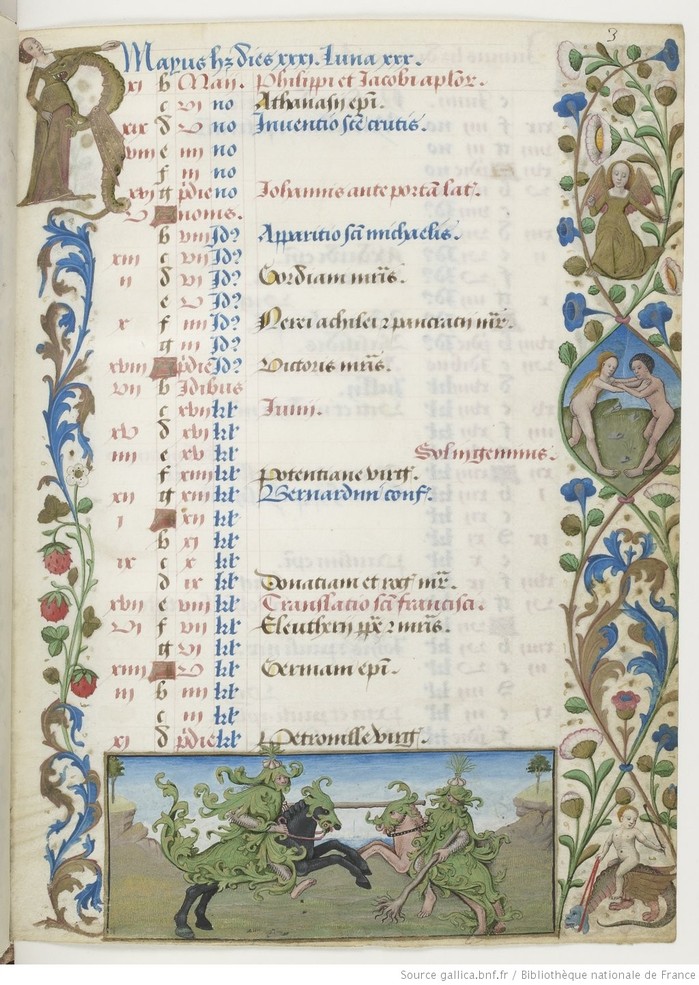
The Utopia, armarium codicum bibliophilorum collection (roughly translates to bookshelf of book-lovers) hosted at e-Codices is the location for privately-held manuscripts who’s owners allowed them to be digitized, but do not wish to be known. From that two books have been recently added, cod.109 and cod.111. Both of these are mid-15th century manuscripts from France, but after that they are distinctly different.
Cod.109 is from Angers, once the capitol of Anjou and about 300km from Paris, and dates from about 1430. It isn’t an unusually beautiful hours, but nicely executed with bright colors and wide borders filled with tiny leaves. The calendar is mostly full, with about 50 empty dates, though there is not a single feast with 2 different saints, not even the common pairing of St. James 1761 and St. Christopher 1757 on July, 25. The error rate is pretty low, only 18, but they seem to come in groups. Some unusual saints seem to reflect the uncommon use, such as St Gratian 3418 (in red) on October 23.
(Db ID: 260)
Bibliothèque nationale de France Nouvelle acquisition latine 3093 is one of the multiple fragments of a complex manuscript, which was owned and possibly comissioned by Jean, Duc de Berry (yes, that Duc de Berry). The BnF fragment, called the Très Belles Heures de Notre-Dame, is mostly Book of Hours content, but the manuscript originally contained a Psalter and some of a Missel as well. Even without touching on the complex history of creation and illumination, the calendar is interesting in it's own right. The entries are mostly standard for Paris, though there are a large number of local bishops specified with their See, (see Sts. Savian and Potencian, October 19, on f.Vv below. Their see of Sens is recorded). There are also some of the specifically Parisian royal feasts, including both the Crown of Thorns (Aug. 11) and Relics of St. Chapelle (Sept. 30) and multiple kings and queens.
The coloring seems to have no pattern at all, sadly. There are 4 colors used, red, blue, pink (distinct from the red, perhaps a faded purple) and black, which might be lost gold, and many of the feasts have size indications in the right margin (3 or 9 lessons, or Annuale), but there seems to be no correlation between color and rank. High-rank feasts are often blue, but in November, where the month is mostly full, it seems to be a simple pattern (blue is roughly every 3rd feast), and St. Andrew, an apostle, is pink.
(DB Id: 197)
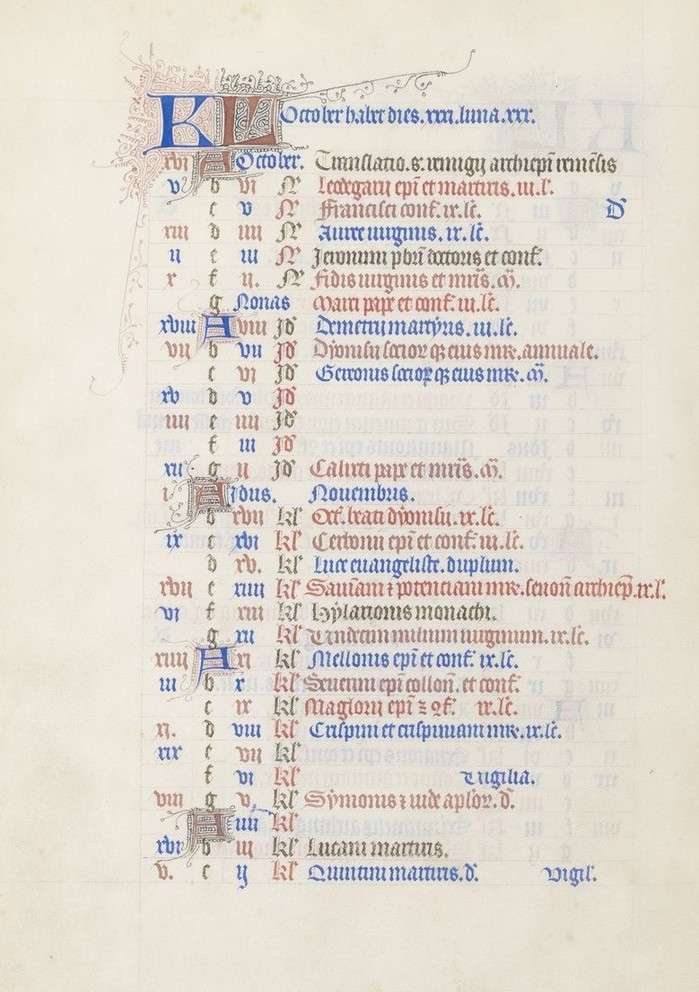
Morgan Library M.92 is another Book of Hours from my recent trip. This one is a very early, 2nd quarter of the 13th century, French book, probably made in Paris but use of Soisson. The first couple of leaves are full-page miniatures of the life of Mary, though only as it pertains to Jesus. They start with the Annunciation and proceed through the scenes of Jesus' first year and then Crucifixion. The last few are the death and accumption of Mary, and these are followed by the calendar, starting on f.15r. This calendar is quite lovely, with rondels for both the labor and the zodiac on the outer margin, and bright gold for the parts of the Roman month (Kalends, Nones, etc)
The calendar is interesting from a scribal-practice sense, as the Lombard capitols, in red and blue, that go with most of the Saints were clearly done by a second scribe. These are wrong quite often, and in ways that are so nonsensical, which is entirely different from the very careful and accurate main scribe. Not all the errors are even on unusual saints, December 25th is "Sativitas d[omi]ni n[ost]ri ih[es]u [christi] in bethle[hem]e" (see f.20v below. The tiny picture is the only one available from the Morgan). The formation of the text in unusual, many more feasts are marked "passio" than one usually finds
(DB ID: 73)
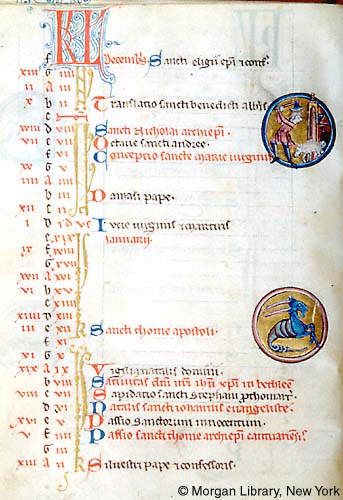
Another Use of Paris Book of Hours from the 15th Century, Boston Public Library MS q.med 82 is a nice, if not spectacular manuscript. The calendar is complete, and has a higher-than-usual number of errors (23), but not nearly as many as the recently added MS. 1841 (DB ID: 116). The calendar is complete except for a missing entry on October 21(see f.10v below), where Ursula and her 11,000 martyrs probably should have been.
(DB ID: 163)
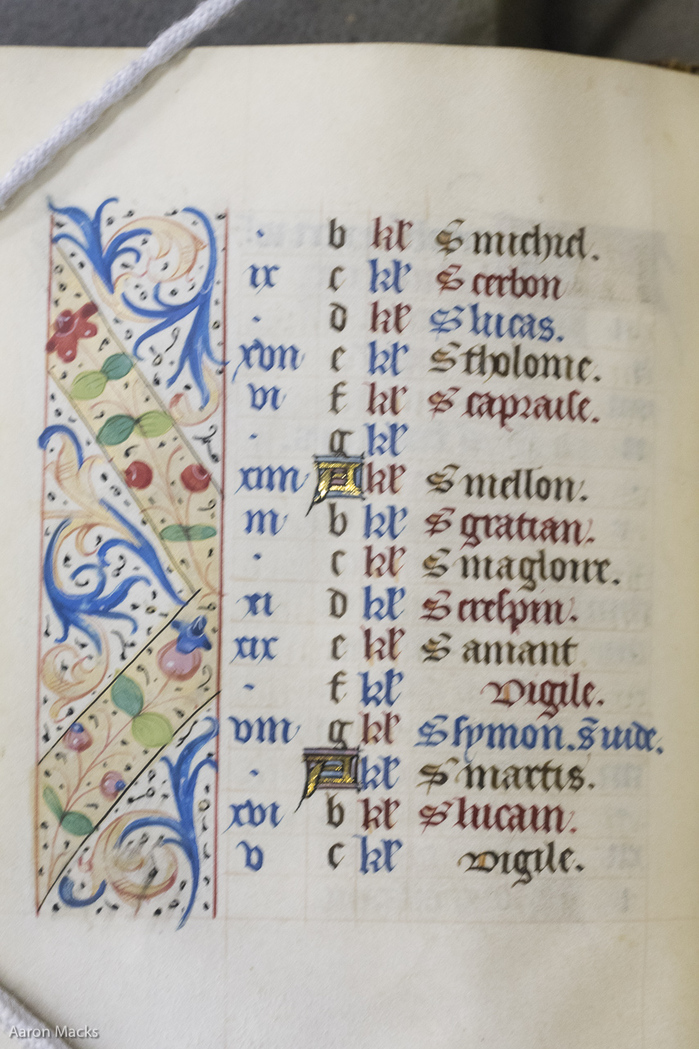
(Photo is mine, from the reading room, hence the low quality
Houghton Library Typ 32 is a mostly plain book of hours, Use of Paris, from about 1420. There's very little decoration, but when there IS, it's impressive, unadorned, unbordered text gives way to a full-block miniature with brightly-colored and gilded foliate borders on all 4 sides. The calendar, sadly, is entirely of the plain category, nothing but the 2-line KL at top to break up the black/red complete calendar pages. Even the text is plain: no double-saint days except the usual 2, St. Leu+Gille and St. James+Christopher; no titles at all; no Egyptian verses or other text outside the calendar apart from the name of the month. The beginning of July (f.7r below) gives a sample of the general feel, though this page has one slightly unusual element. On the 6th, there is the Octave for the Feast of Sts. Peter and Paul, which is very common to see. It is rare, however, to see it with just Peter's name. Usually both are named, or if one dropped, Paul stands alone
(DB Link: 156)

At first blush Harvard's Houghton Library ms Lat 132 is a somewhat unremarkable Use of Rome Hours from Bruges. Though it has 12 lovely miniatures in the style of the "Gold Scrolls group", the calendar is rather boring, red and black with red strikethroughs for medium-importance days like vigils. It was updated at least 2 seperate times, with a second hand writing in black Gothic similar to the original and a third hand in a later batarde . Hidden in it, however, is an interesting clue to the literacy of its owners, October 9th(see f.Fv below). Written in red, this is the Feast of St. Denis, patron of the eponymous cathedral just north of Paris and the martyr for whom Montmartre is named. Denis is a adaptation of his actual Greek/Latin name, Dionysus. The first scribe wrote Dyonisi Epi (Dionysus Bishop), as expected for a calendar in Latin, but the second scribe appended "S. Denis", either not understanding that they are the same, or for a patron who might not know the Latin.
(Link to the DB: 135)
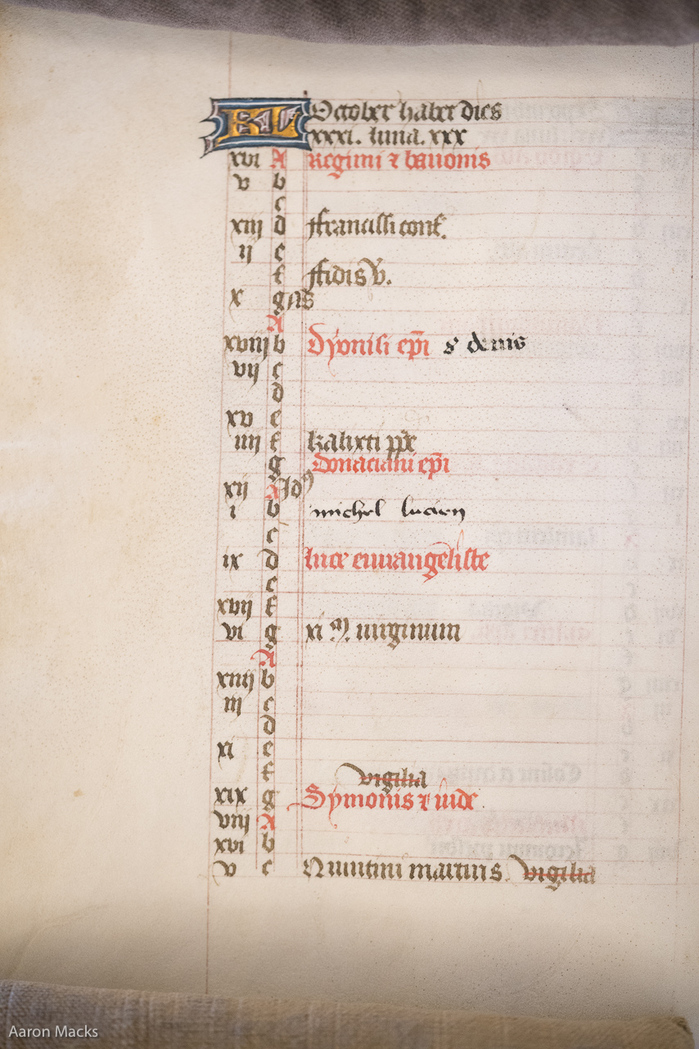
The Very Small Hours of Anne de Bretagne, Bibliothèque nationale de France Nouvelle acquisition latine 3120, is a fascinating tiny use of Rome book of hours from the last 15th Century. It was made in Paris and illuminated by Jean d'Ypres. The calendar is not complete, but very full, with 259 saints and 60 in gold. There are some interesting liturgical notes in the calendar, like the comment "Ultimu[m] Pascha" (the last possible day for Easter) April 24th (f.5v below). Note that it is right-justified with line-filler on the left. This is common throughout the calendar for liturgical notes, Vigils and Zodiac indications. (See in the DB: 142)
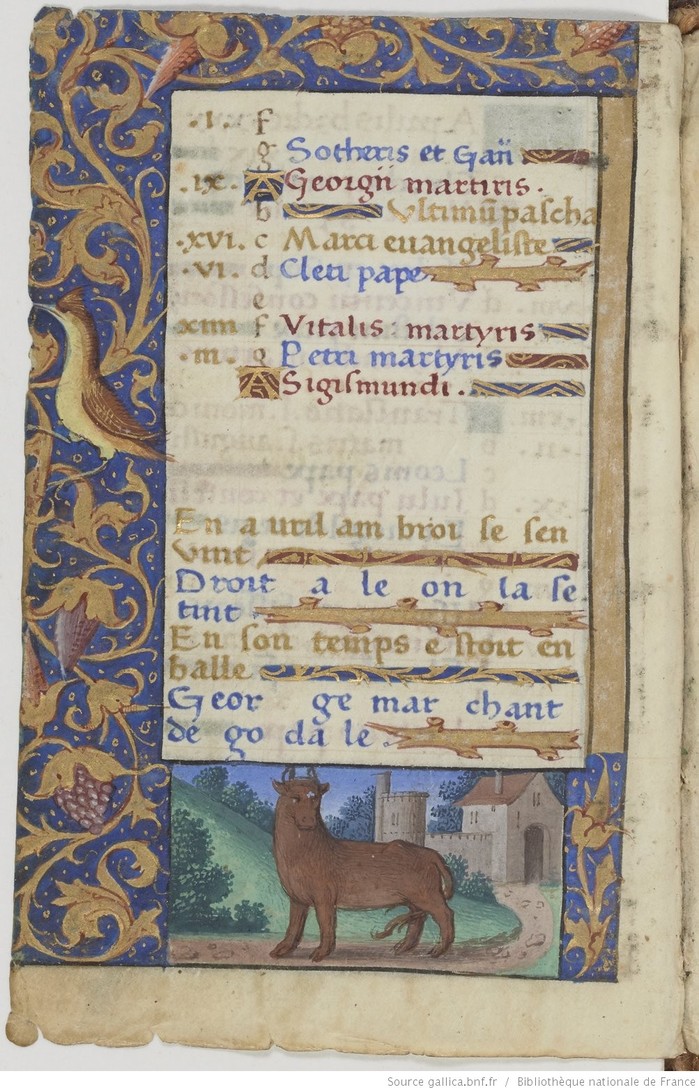
Harvard's Houghton Library MS Lat 251 is a turn-of-the 15th century Parisian book. Though the text is Use of Rome, the calendar is thoroughly Parisian. The text is fragmentary, with both text and illuminations missing, but the calendar is complete, with 260 entries. F.1r, below, is a good representitive of the decoration scheme, with banded foliage on the outer edge in muted colors. Also note the unusual missing entries for January 2-4, where the Octaves of Stephen, John and the Innocents would usually be.
